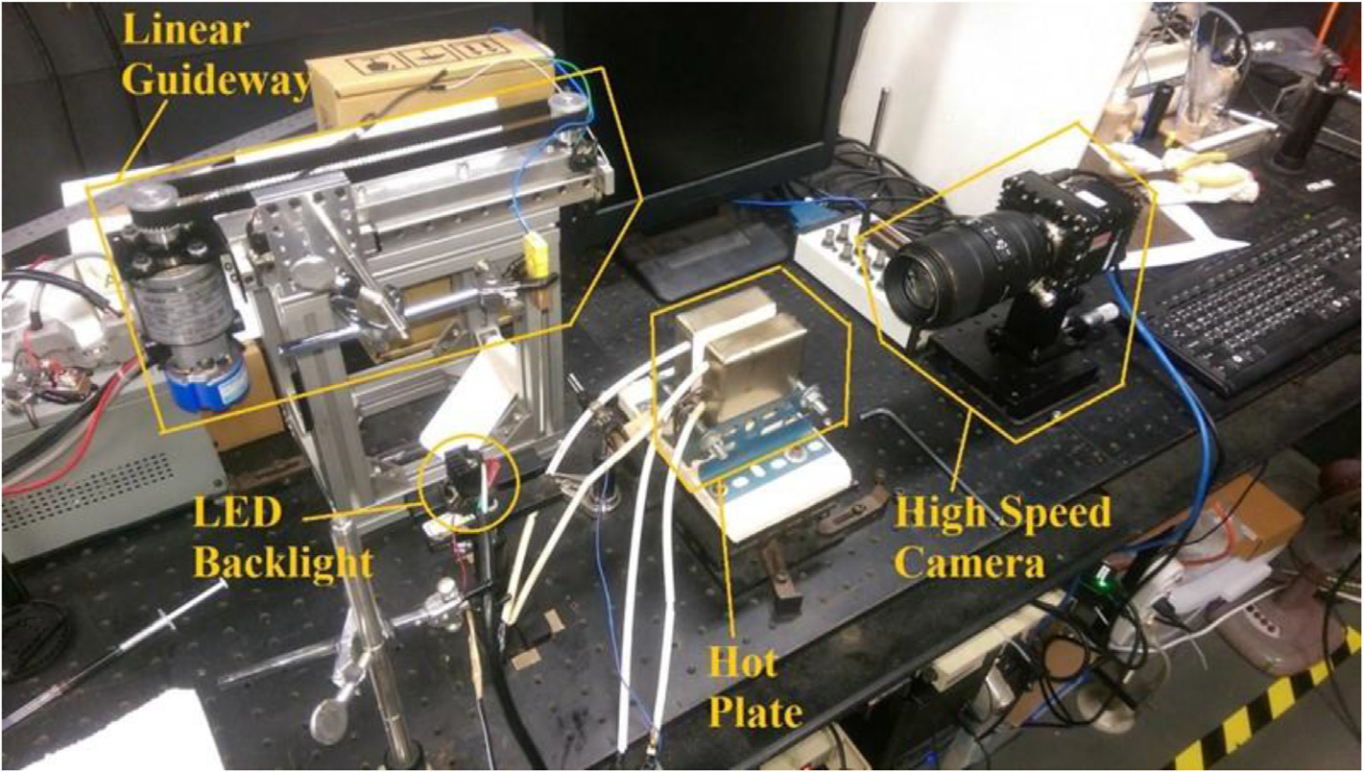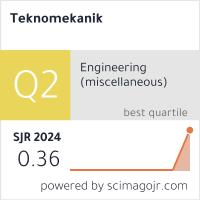Utilization of Sewage Sludge Using Multiple Thermal Conversion Processes
DOI:
https://doi.org/10.24036/teknomekanik.v4i2.11572Keywords:
Sewage sludge, Palm Kernel Shell (PKS), Sludge Pyrolytic Oil (SPO), Combustion, Co-gasificationAbstract
Sewage sludge is a usual waste from urban areas that can be utilized in many renewable energy sources. In this study, we examine the sewage sludge utilization using pyrolysis process to produce pyrolytic oil using Taguchi methods, combustion characteristic of sludge pyrolytic oil (SPO) blend with heavy fuel oil (HFO), and co-gasification of sewage sludge with CO2/steam as the gasification medium using Taguchi methods. The best-operating conditions for the pyrolysis of sewage sludge are a heating rate of 10oC/min, temperature of 450oC, the residence time of 60 min, and N2 flow rate of 700 mL/min. Under these conditions, the obtained pyrolytic oil yield is very close to the result from the Taguchi method calculation. In the combustion characteristic of sludge pyrolytic oil (SPO) blend with heavy fuel oil (HFO), a higher SPO in the fuel blend enhances the occurrence of micro-explosion and reduces the size of the residual. Higher SPO content in the fuel blend increases the combustion rate and increases the ignition delay due to moisture evaporation. In the co-gasification of sewage sludge and palm kernel shell optimization using Taguchi method, the best operational condition for maximum H2/ CO syngas ratio reaches at the gasification temperature of 900 C, a blending ratio of 30%, a CO2/(CO2+H2O) ratio of 70%, and a catalyst addition of 20% bed material mass. The best operating condition for maximum concentration of H2 reach with gasification temperature of 800 C, a blending ratio of 40%, a CO2/(CO2+H2O) ratio of 70%, and a 15% catalyst addition of bed material mass. The CO2/(CO2+H2O) ratio is the most important parameter among both case.
Downloads
References
G. B. Chen, Y. H. Li, T. S. Cheng, and Y. C. Chao, “Chemical effect of hydrogen peroxide addition on characteristics of methane-air combustion,” Energy, vol. 55, pp. 564–570, Jun. 2013, doi: 10.1016/j.energy.2013.03.067.
A. Starikovskiy and N. Aleksandrov, “Plasma-assisted ignition and combustion,” Prog. Energy Combust. Sci., vol. 39, no. 1, pp. 61–110, 2013, doi: 10.1016/j.pecs.2012.05.003.
W. Kaminski, J. Marszalek, and A. Ciolkowska, “Renewable energy source-Dehydrated ethanol,” Chem. Eng. J., vol. 135, no. 1–2, pp. 95–102, 2008, doi: 10.1016/j.cej.2007.03.017.
P. S. Nigam and A. Singh, “Production of liquid biofuels from renewable resources,” Prog. Energy Combust. Sci., vol. 37, no. 1, pp. 52–68, 2011, doi: 10.1016/j.pecs.2010.01.003.
J. Werther and T. Ogada, “Sewage sludge combustion,” Prog. Energy Combust. Sci., vol. 25, no. 1, pp. 55–116, 1999, doi: 10.1016/S0360-1285(98)00020-3.
S. M. Al-Salem, A. Antelava, A. Constantinou, G. Manos, and A. Dutta, “A review on thermal and catalytic pyrolysis of plastic solid waste (PSW),” J. Environ. Manage., vol. 197, no. 1408, pp. 177–198, 2017, doi: 10.1016/j.jenvman.2017.03.084.
A. P. Bora, D. P. Gupta, and K. S. Durbha, “Sewage sludge to bio-fuel: A review on the sustainable approach of transforming sewage waste to alternative fuel,” Fuel, vol. 259, no. October 2019, p. 116262, 2020, doi: 10.1016/j.fuel.2019.116262.
Z. Wang et al., “Co-pyrolysis of sewage sludge and cotton stalks,” Waste Manag., vol. 89, pp. 430–438, 2019, doi: 10.1016/j.wasman.2019.04.033.
A. Zaker, Z. Chen, X. Wang, and Q. Zhang, “Microwave-assisted pyrolysis of sewage sludge: A review,” Fuel Process. Technol., vol. 187, no. February, pp. 84–104, 2019, doi: 10.1016/j.fuproc.2018.12.011.
T. Lu, H. R. Yuan, S. G. Zhou, H. Y. Huang, K. Noriyuki, and Y. Chen, “On the pyrolysis of sewage sludge: The influence of pyrolysis temperature on biochar, liquid and gas fractions,” Adv. Mater. Res., vol. 518–523, pp. 3412–3420, 2012, doi: 10.4028/www.scientific.net/AMR.518-523.3412.
I. Fonts, G. Gea, M. Azuara, J. Ábrego, and J. Arauzo, “Sewage sludge pyrolysis for liquid production: A review,” Renew. Sustain. Energy Rev., vol. 16, no. 5, pp. 2781–2805, 2012, doi: 10.1016/j.rser.2012.02.070.
D. B. Spalding, “Experiments on the burning and extinction of liquid fuel spheres,” Fuel, vol. 32, no. 2, pp. 169–185, 1953.
S.-W. Kang, J.-I. Dong, J.-M. Kim, W.-C. Lee, and W.-G. Hwang, “Gasification and its emission characteristics for dried sewage sludge utilizing a fluidized bed gasifier,” J. Mater. Cycles Waste Manag., vol. 13, no. 3, pp. 180–185, 2011, doi: 10.1007/s10163-011-0016-y.
A. A. Oladejo, M. O. Oyama, K. O. Ayeni, E.-O. Ayo, and A. S. Oyerinde, “In vitro Evaluation of Antibacterial and Antifungal Activities of Chrysophyllum albidum Stems Bark,” J. Adv. Microbiol., vol. 13, no. 2, pp. 1–7, 2018, doi: 10.9734/jamb/2018/32983.
M. C. Samolada and A. A. Zabaniotou, “Comparative assessment of municipal sewage sludge incineration, gasification and pyrolysis for a sustainable sludge-to-energy management in Greece,” Waste Manag., vol. 34, no. 2, pp. 411–420, 2014, doi: 10.1016/j.wasman.2013.11.003.
A. Ramos, E. Monteiro, V. Silva, and A. Rouboa, “Co-gasification and recent developments on waste-to-energy conversion: A review,” Renew. Sustain. Energy Rev., vol. 81, no. June 2016, pp. 380–398, 2018, doi: 10.1016/j.rser.2017.07.025.

Downloads
Published
Issue
Section
License
Copyright (c) 2021 Ta-Hui Lin, Annas Fauzy, Guan-bang Chen, Fang-Hsien Wu (Author)

This work is licensed under a Creative Commons Attribution 4.0 International License.




